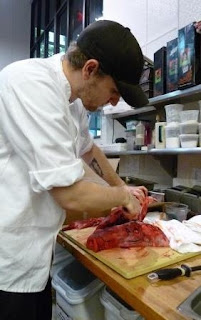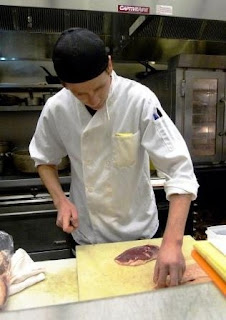by L'Etoile cook, Marcelle Richards
Meet Mike, Aaron and Ryan, L’Etoile’s sous chefs past, future and present.
On Saturday, L’Etoile said goodbye to former sous chef Mike Balistrieri, as Aaron Mayhew makes his debut this week to work alongside L’Etoile veteran Ryan Klawitter.
Outside of the restaurant industry, I find that people are sometimes unclear about what a sous chef does, and they do a lot.
While Chef Tory takes care of the grand picture for both restaurants, the sous chefs are the less publically known but ever-present support who hold L’Etoile’s standards high even when Chef Tory is out of the kitchen.
“If Tory was the head of the kitchen, the sous chefs would be the hands and the cooks would be the fingers,” said Mike Balistrieri as he flashes a smile. “I’ve been thinking of that one.”
Despite the physicality of their work, it’s a great deal of heart that keeps them in it.
They’re the ones who are often at work by late morning before the line cooks arrive and they often stay just as late, making sure the restaurant is not only prepared for that day’s service but for long term needs as well.
Mike, and now, Aaron, function as on-line (as in on the cooking line) leader, helping cooks during rushes, or filling in for stations and helping with prep needs.
Ryan more so takes care of much of the restaurant’s ordering, purveyor relations, plus tasting and checking food as it’s prepared and sent out. With a relish for pickling, preserving, and charcuterie, he loves to dabble with seasonal produce and items that might otherwise be wasted, like offal or meat scrap, to utilize products to their fullest potential.
Between he and Jed Heubel, he says they make about 90 percent of the restaurant’s charcuterie: pâtés, sausages, and cured meats. “That’s definitely one of my favorite things, right there,” he said.
 |
| sous chef Ryan and his pig head |
Ryan looked like a kid at Christmas when six Uplands whey-fed, acorn-finished hogs arrived on Friday, only inside his box were six, dare I say, smiling, pigs heads. They really did look happy, as I would be too, I thought, if I had been fattened on Uplands whey.
“TV makes being a chef a glamorous thing but it’s really hard work. It’s also really rewarding especially if you love what you do,” he said.
Aside from a sense of duty and working for a chef he greatly respects, he’s found that he also enjoys the teaching aspect, which perhaps is something I’ve benefited from most directly as an intern.
When I think of Ryan, he’s the person who’s made me a better taster. When I bring something to Ryan to taste, I may have to make corrections, or even start over, but each is a learning experience that’s helped me better understand the nuances of what makes flavors balance. It’s Ryan’s eagle eye for detail, too, that’s really hit home the mantra that I believe does separate L’Etoile from others, and that is, as he’s said to me and others: “If it’s not right, don’t send it out.”
Ryan likes Ben and Jerry’s, Danzig and Pickles and Preserves by Marion Brown.
Mike has been somewhat of the mother hen figure to me. On the line when I’ve felt like the rush was getting the better of me, Mike has been there to say, “We’re going to get through this. It’s fun.” There’s a calm about working with Mike, and I think most will agree, that makes him a person who leads by quiet example. It’s he who helped me to learn to keep calm and carry on...and to have fun.
One of my favorite memories of Mike is of him shouting German sentences in the kitchen on request – it’s quite possibly the only time he’s seemed remotely scary.
Mike likes mushroom foraging, roux and his Jeep, Andy.
 |
| sous chef Mike and his cleaver |
I know we’ll all miss him and his beloved cleaver. Most chefs use…chef’s knives – which Mike does use sometimes, he says, but even at the expense of some good-humored jabbing, the cleaver is still his baby.
The whole cleaver trend started, Mike said, when the kitchen was more crowded and the blunt-headed cleaver seemed like a less potentially pokey tool to wield.
“It just feels right in your hand,” he said emphatically.
Mike is moving to Appleton to be with his other love, his fiancée Janine. He doesn’t yet know where he’ll be working but he knows he’ll stay in the restaurant industry. He says he’ll miss the team mentality at L’Etoile – a rarity in a kitchen, he notes. “This is by far the most professional, driven kitchen I’ve worked in…we’re all here because we want to make this restaurant the best we could,” he said.
Aaron shares in Mike and Ryan’s appreciation for the hard-working environment that is the L’Etoile kitchen and loves developing relationships with farmers and working with the top-notch products they provide. He graduated from the Culinary Arts program from Madison College in 2008 and has been at L’Etoile since August 2010. “It’s finally an opportunity – seeing as I kind of came up from the bottom – to instill the knowledge I’ve been taught and pass that onto others,” he said.
 |
| new sous chef Aaron |
Given the decision to hire from within versus without, Chef Tory notes that “it’s always best when someone knows the restaurant, knows the system, knows how I like things done…plus Aaron’s a good guy.”
Aaron’s goal is “to not have this restaurant skip a beat” as he steps in to help the restaurant continue to develop systems and “achieve even higher quality.”
His cousins recently dined at L’Etoile and they said it was one of the best meals they’d ever had, and knowing that his food will mean something special to those who eat it is one of the job’s greatest payoffs to him. He said he always tries to keep that in mind, and that’s really what the job is all about.
Aaron likes – no, loves – the Packers. Crispy duck skin and Phish are right up there as well.
So what is it that sous chefs here do? They do things right.
















